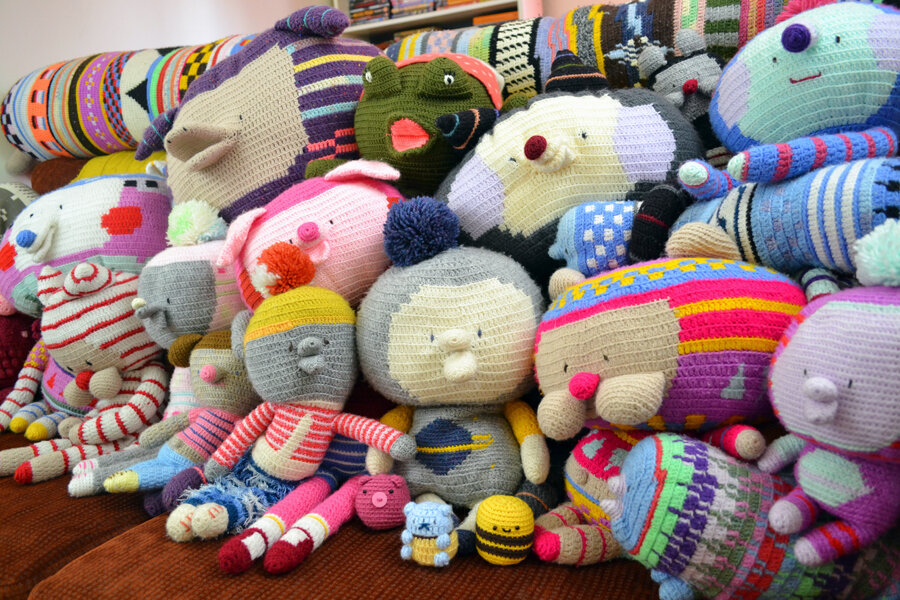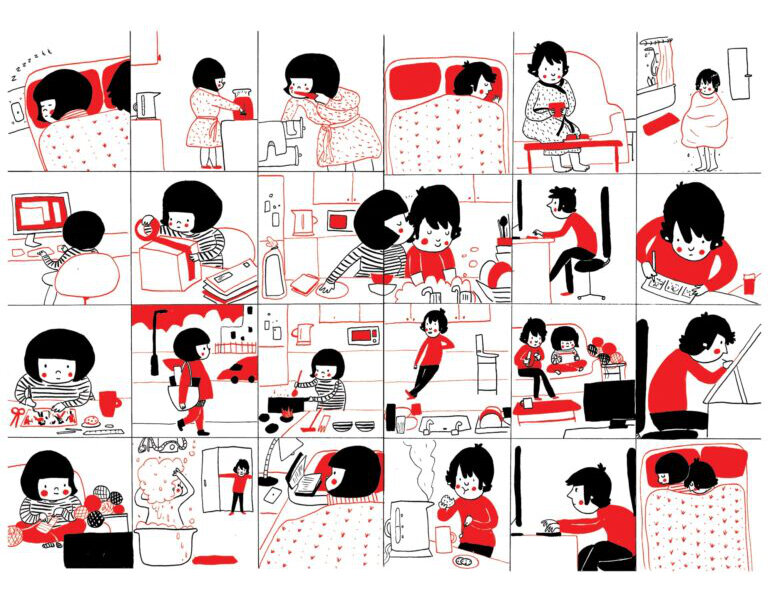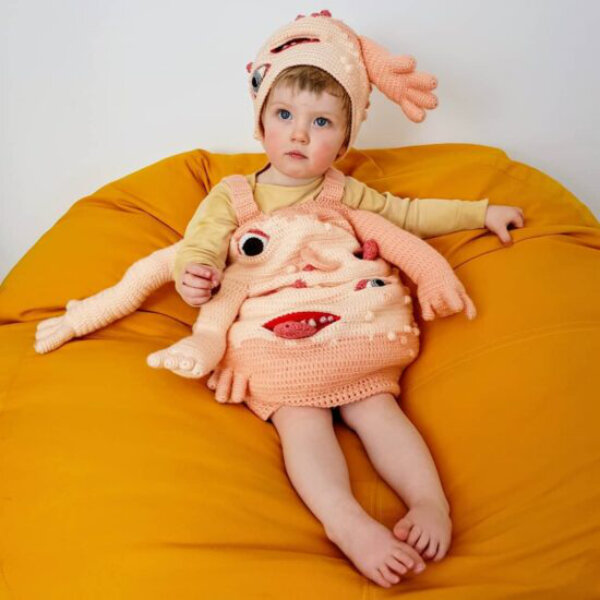
PHILIPPA RICE: THE BALANCING ACT OF KEEPING IT REAL
Philippa Rice, known as the # 1 New York Times bestselling author of ‘Soppy,’ is an artist working in a number of different media including comics, illustration, animation, model making and crochet. Philippa lives in Nottingham, UK, with her partner Luke Pearson and their daughter, and has recently released ‘BABY: A Soppy Story’ a collection of all new comics and illustrations about the small, intimate moments of a couple expecting their first baby.
We met spontaneously at her exhibition during the Pictoplasma Conference 2019 where she introduced us to her growing family of characters, gave insights into her working process, talked about the difficulties of finding the right work/life balance, and the importance of being honest…
Pictoplasma: Can you describe your exhibition space?
Philippa Rice: It’s a small room in a big, spooky house in a graveyard. And I think this thing over here is an oven?
This used to be a kitchen.
Yeah, some kind of strange functional room… Anyway I’m showing several pages from my first comic book ‘Sophie’ and its sequel ‘Baby,’ which comes out next year. So this is all new material. I’ve got a little plinth here with some small character sculptures made of painted modeling clay—around fifteen of them. Then in the other corner, I’m showing a big display of my crochet characters. A whole bunch, different sizes, all arranged nicely together on their plinths. They’ve been sitting there very patiently for the last few days…

How did you get into crocheting?
I used to make crochet characters in the past to sell, but all of these here are currently living in my house. A few of them feature in my animated GIFs and videos.
“They all tend to be quite obnoxious, bossy, and desperate for attention. That’s something they all share.”
Some look new, some look a little worn out, as if someone has played with them.
Yes, some of them have been played with more than others. Mainly I’ve been playing with them, because I’ve been animating them, but of course my daughter likes playing with them as well. Some of them I won’t let her have, because they’ve got wires in them, or things that she’ll break.
What does your daughter think about the fact that they’re now in an exhibition?
Well, she’s deeply upset because she’s not allowed to touch them for a while. That’s why she refuses to come up.
Do all these characters have their own personalities?
Oh yes, they also have names. Those that have featured in my videos are the stars. Others are more obscure. This one here is David. And that one over there was the inspiration for one of Luke’s characters in Hilda.
Is it a worm?
It’s a long boy! It’s a made-up thing, a worm with legs—or a living draft excluder, to keep the cold air from coming in under the door… Anyway, the character that Luke created from him ended up being human. Then, this beaver-bear thing here is called Eglington. She’s a big star from my videos and animated gifs. This one is Donathan, a little mouse. And this is Lenny, one of the earlier ones. He has wires in his arms and legs, so I won’t let my daughter touch him.
Tell us about their inner character.
They all tend to be quite obnoxious, bossy, and desperate for attention. That’s something they all share.
How long does it take to create one?
I can probably make a small one in just a few hours, usually while I’m watching a film or some TV series in the evening. So it doesn’t really seem like labor. A bigger one, I don’t even know, but by the time it’s done it feels like I’ve been working on it forever. For example, Maxine and Dandrew are both hand puppets, so they have a more complicated structure on the inside. That’s much more elaborate.
How do you animate them?
It’s all stop-motion. In videos I usually show them sitting, so I don’t have to worry about animating them walking around. It’s mainly the faces that are animated. I can also move the hands and arms using the inside wiring and pins if they need to hold something. The good thing about crochet is that it’s actually quite flexible and will hold its shape. I can squash it and stretch it—it works really well for animation.

What’s the story with these little clay models.
I make a lot of these. Some of them I’ll sell at comic shows and craft fairs, but I really just like making them: so many little characters, each one different.
“… in general I find it easier to make my decisions while I’m drawing, rather than having to make them on the computer”
When did you start making comics?
That was towards the end of 2011, so quite a long time ago. My first book came out around 2014.
You actually color all your artwork by hand and not digitally.
That’s the way I started back when I did my first book. I really just wanted to work traditionally with red and black ink on white paper. The entire coloring is done hands-on, and I still enjoy working that way. I do use Photoshop to select colors, adjust their level, and get things ready for print, but in general I find it easier to make my decisions while I’m drawing, rather than having to make them on the computer.

What’s the new book about?
It’s all about having a baby. While I was pregnant, and also after my daughter was born, I kept like a diary and tried to write everything down, no matter how seemingly insignificant, so I wouldn’t forget. Later, when the time came to pitch a new book, I was prepared: All I had to do is look at my notes and simply pick my favorite moments to turn them into a comic.
Having a baby is a full time job…
… But also gives you a lot of time to think! When my daughter was newly born, I was actually working on another book, ‘Sister BFFs,’ that came out last year and has absolutely nothing to do with having a baby. That was quite good, because it enabled me to think about something else for a little while—when you’re dealing with a baby all the time, you don’t want to constantly draw it as well. But after a while I was ready to start, and thanks to my diary it was nice to remember and revisit that early stage where a lot is happening, it’s all new, weird, funny—and moving extremely quickly. You tend to forget those moments instantly.
“When I read comics by other authors about difficult moments in their life, I feel really grateful.”
The book also features a couple of very private instances that you’ve decided to make public.
When I read comics by other authors about difficult moments in their life, I feel really grateful. So when I work on my comics, I hope someone else can feel like, ‘oh yeah, that’s honest,’ and they can relate.

Do you have discussions with Luke about what you are allowed to reveal?
Oh yes, absolutely! I have to show him everything, and definitely make sure he’s happy with it—but he always is. He is fine with me depicting him as long as he feels it’s accurate. In a way, he makes sure that I don’t just make stuff up, but keep it real.
You and Luke also work in the same space?
We both work from home and we have a shared studio to go to as well, which we do far too seldom. It’s difficult to find the perfect arrangement. We take it in turns with childcare and work. It’s a balancing act really.
What’s your next project?
Well, I’ve just finished the book, so I don’t think I want to go straight to the next one. Right now I’m hoping to make more crochet characters and animations again. These things just take ages and you need time and space to do it. Now that I’ve finished my book, I feel like giving it another go.

Interview by Elise Graton on the occasion of Pictoplasma Berlin, 2019
- 205 views
- 0x empathizes